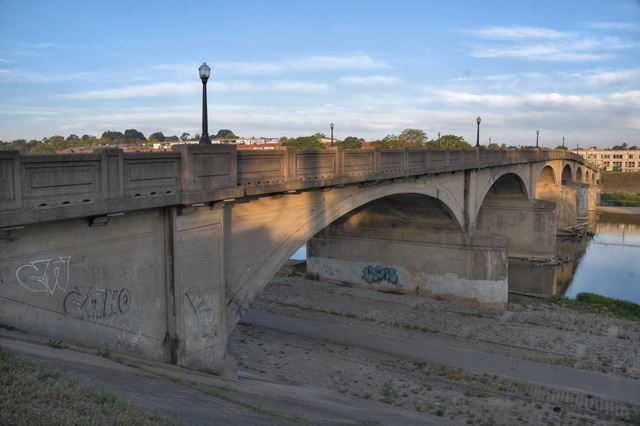We Recommend:
Bach Steel - Experts at historic truss bridge restoration.
BridgeHunter.com Phase 1 is released to the public! - Visit Now
Black Street Bridge

Primary Photographer(s): Nathan Holth
Bridge Documented: September 22, 2019
Hamilton: Butler County, Ohio: United States
Not Available or Not Applicable
93.0 Feet (28.3 Meters)
708.0 Feet (215.8 Meters)
28 Feet (8.53 Meters)
7 Main Span(s)
960020

View Information About HSR Ratings
Bridge Documentation
This bridge is a long, multi-span concrete arch bridge noted for its architectural beauty and lack of alteration. Many such bridges that used to exist in Ohio in cities like Dayton and Columbus have been demolished, therefore this bridge has become fairly rare.
View Archived National Bridge Inventory Report - Has Additional Details and Evaluation
View Historical Article About This Bridge
Information and Findings From Ohio's Historic Bridge InventorySetting/Context The bridge carries a 2 lane road and sidewalks over the Great Miami River at Hamilton. There are railroad facilities at one end of the bridge and a commercial district at the other. Physical Description The 7 span, 708'-long, reinforced-concrete arch bridge has paneled concrete parapets with oversize blocky end posts topped by urns. The spandrels are paneled. The arch rings have shadow lines for accent. There are paneled pilasters at the piers. The bridge is supported on bullnosed piers with horizontal scoring. Summary of Significance The 1922 deck arch bridge is a complete and nicely detailed, multiple-span example. The eligible recommendation of the prior inventory remains appropriate. The 2007-08 ODOT Historic Bridge Inventory Update (Phase 1A) has identified more than 225 extant, reinforced-concrete, closed-spandrel arch bridges dating from 1896 to 1959. Fewer than 30 examples date to before 1910. These tend to represent innovative technology or early attempts at exploring the aesthetic qualities of the moldable material; earlier examples tend to have higher historical and technological significance than the later examples. Use of the reinforced-concrete, closed-spandrel arch technology reached its height during the 1910s and 1920s with more than 80% of Ohio's surviving examples dating from those two decades. The later examples generally do not represent innovative technology, although they sometimes have high aesthetic merit or significant settings/contexts. "Closed spandrel arch bridges are the most basic of reinforced concrete bridge types. Closed spandrel means that the area between the deck and the arch ring was filled in. The spandrel wall actually serves as a retaining wall in the bridge, holding the fill material. Live loads are borne by the fill material and by the spandrel walls. The arch may be constructed either as a single structural element (barrel) or in separate parallel longitudinal ribs. The barrel arch design has some structural and visual similarities to stone arch bridges. The barrel arch is also sometimes faced with brick or stone, making it appear similar to a masonry arch bridge. This type of bridge is suitable for short span lengths. Closed spandrel concrete arches predate open spandrels, as the closed spandrel type harkens back to the stone arches that the earliest forms imitated. This type was not built for long as engineers realized that significant material could be saved and a reduction in weight could be achieved by eliminating the filled section. Hence, open spandrels were born. Filled spandrel concrete arches date primarily from the earliest decades of reinforced concrete (1890s through 1920s). They are not as common as many of the standardized bridge types built during this same era, such as concrete slabs and girders. They are significant because they are not common and represent the evolution of concrete technology. To be considered significant, filled spandrel arches should have integrity, through the retention of their character-defining features: arch ring, barrel, spandrel wall, railing or parapet, end posts, piers and/or abutments and wingwalls." [From: A Context for Common Historic Bridge Types by Parsons Brinckerhoff, October 2005] Justification The 1922 reinforced-concrete deck arch bridge has a high level of significance because of its association with the Miami Conservancy District's flood-control project. It is one of two arch bridges that were built directly by the Conservancy following the Great Flood of 1913. The other bridge (Adams Street in Troy) was recently replaced. The bridge is one of over 210 extant examples built in the state starting in 1897. It was during the first decade of the 20th century that the bridge type gained currency, and in Ohio the golden age of reinforced concrete arches was the two decades following World War I when over 140 of the remaining examples were constructed by cities, counties, and the bridge division of the state highway department under the leadership of J.R. Burkey and D. H. Overman. Bridge Considered Historic By Survey: Yes |
![]()
Photo Galleries and Videos: Black Street Bridge
Bridge Photo-Documentation
Original / Full Size PhotosA collection of overview and detail photos. This gallery offers photos in the highest available resolution and file size in a touch-friendly popup viewer.
Alternatively, Browse Without Using Viewer
![]()
Bridge Photo-Documentation
Mobile Optimized PhotosA collection of overview and detail photos. This gallery features data-friendly, fast-loading photos in a touch-friendly popup viewer.
Alternatively, Browse Without Using Viewer
![]()
Maps and Links: Black Street Bridge
Coordinates (Latitude, Longitude):
Search For Additional Bridge Listings:
Bridgehunter.com: View listed bridges within 0.5 miles (0.8 kilometers) of this bridge.
Bridgehunter.com: View listed bridges within 10 miles (16 kilometers) of this bridge.
Additional Maps:
Google Streetview (If Available)
GeoHack (Additional Links and Coordinates)
Apple Maps (Via DuckDuckGo Search)
Apple Maps (Apple devices only)
Android: Open Location In Your Map or GPS App
Flickr Gallery (Find Nearby Photos)
Wikimedia Commons (Find Nearby Photos)
Directions Via Sygic For Android
Directions Via Sygic For iOS and Android Dolphin Browser
USGS National Map (United States Only)
Historical USGS Topo Maps (United States Only)
Historic Aerials (United States Only)
CalTopo Maps (United States Only)

